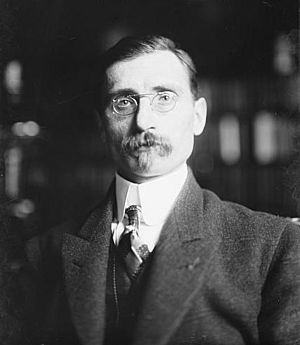Guglielmo Ferrero facts for kids
Quick facts for kids
Guglielmo Ferrero
|
|
|---|---|
 |
|
| Born | 21 July 1871 |
| Died | 3 August 1942 (aged 71) |
Guglielmo Ferrero (born July 21, 1871 – died August 3, 1942) was an Italian historian, journalist, and writer. He is best known for his five-volume work, Greatness and Decline of Rome. Ferrero strongly believed in freedom and individual rights. He was against any kind of dictatorship or government that had too much power.
Contents
A Life of Learning and Writing
Guglielmo Ferrero was born in Portici, a town near Naples, Italy. He studied law in different cities like Pisa, Bologna, and Turin. Later, he married Gina Lombroso, whose father, Cesare Lombroso, was a famous expert in criminology. Guglielmo and Gina even wrote a book together called The Female Offender.
Between 1891 and 1894, Ferrero traveled a lot around Europe. In 1897, he wrote a book called The Young Europe, which was quite important and even influenced the famous writer James Joyce.
While studying the history of Rome, Ferrero also wrote for a literary magazine called La Ronda. He then started writing political essays and novels. Some of his novels include Between Two Worlds (1913) and The Two Truths (1933-1939).
Standing Up to Dictatorship
In 1925, when the fascist government, led by the Black Shirts, forced many thinkers to leave Italy, Ferrero refused to go. Because of this, he was put under house arrest. This meant he had to stay in his home and could not leave freely.
In 1929, Ferrero accepted a job as a professor at the Graduate Institute of International Studies in Geneva, Switzerland. His later works focused on the French Revolution and Napoleon. These books included Adventure, Bonaparte in Italy, and The Principles of Power. In 1935, his daughter Nina Ferrero married a diplomat from Yugoslavia named Bogdan Raditsa.
A Visit to the White House
In 1908, Guglielmo Ferrero was invited to the White House in the United States by President Theodore Roosevelt. President Roosevelt had read Ferrero's famous book, The Greatness and Decline of Rome, and was very impressed. Ferrero gave many talks in the northeastern parts of the USA. These talks were later collected and published as a book called Characters and Events of Roman History.
Guglielmo Ferrero passed away in 1942 in Mont Pèlerin, Switzerland.
Important Books
Guglielmo Ferrero wrote many books, especially about history. His most famous work is The Greatness and Decline of Rome, which was translated into English in five volumes.
Books in English
- The Greatness and Decline of Rome: This big work explores the history of ancient Rome.
- Volume 1: The Empire-Builders (1907)
- Volume 2: Julius Caesar (1907)
- Volume 3: The Fall of an Aristocracy (1907)
- Volume 4: Rome and Egypt (1908)
- Volume 5: The Republic of Augustus (1909)
- Characters and Events of Roman History from Caesar to Nero (1909)
- The Women of the Caesars (1911)
- Ancient Rome and Modern America: This book compared the ways of life in ancient Rome and modern America (1914).
- A Short History of Rome (with Corrado Barbagallo), translated in two volumes (1918).
- The Reconstruction of Europe: Talleyrand and the Congress of Vienna 1814-1845 (1941)
See also
 In Spanish: Guglielmo Ferrero para niños
In Spanish: Guglielmo Ferrero para niños

